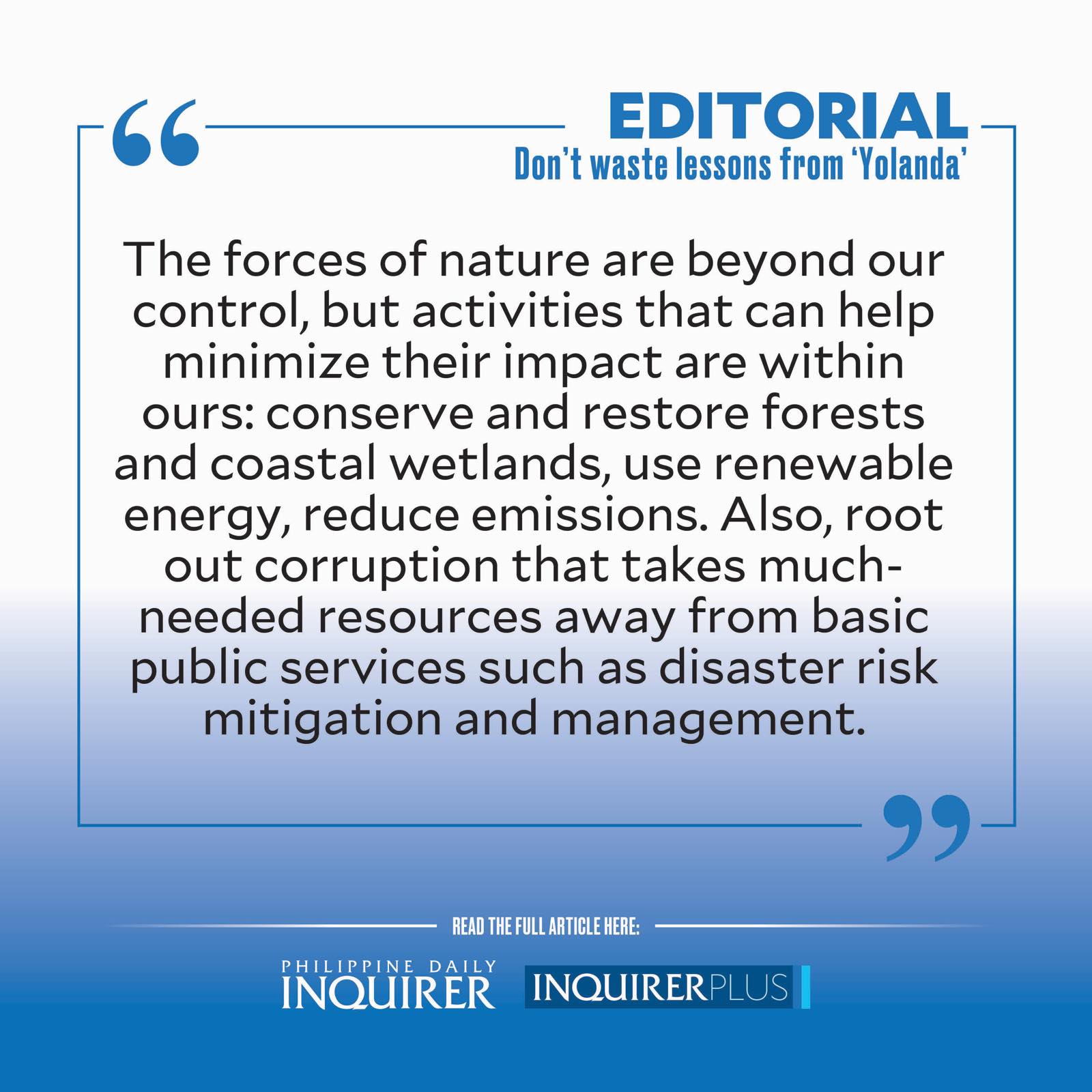
Most recollection of the night before Supertyphoon Yolanda (international name: Haiyan) hit land 10 years ago was about the fair weather, literally the calm before the storm.
Those in central Philippines — where the storm was expected to make landfall — were complacent despite repeated warnings from the weather bureau. A category 5 supertyphoon? “We are used to storms,” they said. This country is visited by an average of 20 typhoons a year. They have survived countless storms, this shouldn’t be any different.
The Pagasa weather bulletin issued at 8 p.m. on Nov. 7, 2013, stated: “Haiyan is expected to affect regions in its path with very strong, possibly destructive winds, heavy to intense rainfall and storm surge.” The majority never imagined the devastating impact of a “storm surge,” an unfamiliar term even for those who lived by the treacherous seas. Some stayed put, while those who evacuated thought it was a pointless precaution. They expected the storm to pass just like all the others they had survived.
Then it came. Yolanda unleashed winds of up to 315 kilometers per hour. At 4:30 a.m. on Nov. 8, 2013, people in Leyte and Samar woke up to howling winds as the weather became violent and visibility turned zero. Within an hour, up to seven meters of storm surges flattened towns and cities stretching 6,000 kilometers, with Tacloban City the hardest hit. After six long hours, as a first responder wrote in a 2013 account, “there was silence.” Silence that spoke of the 6,300 people dead, 4 million displaced, and countless other lives upended. Today, thousands are still missing and many remain unidentified in mass graves.
The bow of the 3,000-ton cargo vessel MV Jocelyn, which was washed ashore plowing 14 houses and killing 11 people in the process, now stands in a memorial park and serves as a reminder of the devastation. Yolanda remains a precautionary tale of how typhoons can wreak havoc and a stark reminder of how they will be more powerful and deadly as world temperature increases — a phenomenon largely driven by human activities.
Undoubtedly, it has educated people about storm categories and made them more receptive to early warning systems, which the government has invested in after Yolanda. Preemptive evacuations have become standard practice while technology has been widely used to spread information — from identifying potential danger areas to predicting ground impact including that of storm surges, now a term that everyone understands with an element of fear, especially for those who witnessed its destruction in 2013.
But all these should never drive us to complacency. It is one thing to predict weather more accurately and another to help people be disaster-proof, an impossible goal because no one can truly escape nature’s wrath unscathed. Even ordinary rains could impact lives, much more than a strong typhoon or earthquake. During Yolanda, even the mayor of Tacloban found himself clinging to the ceiling to survive. In a calamity, nature does not discriminate between the haves and the have-nots, but it is in the aftermath, in the rebuilding and recovery, where the difference becomes stark.
As the late Conrado de Quiros, writing about Typhoon “Mario” (Fung-wong) in his last column for this paper, (“Elephant in the room,” There’s the Rub, 9/23/14) said: “[I]t’s the poor who take the brunt of storms, deluge and other ravaging … [T]here’s much to fear in future downpours and torrential rains and great floods coming this way … Which will devastate the poor most of all. Which will wreak havoc on those who can afford the least havoc in their lives. Which will leave bereft those who are already mind-bogglingly bereft. Mahirap ang mahirap.”
The government must keep on ensuring that people don’t build flimsy dwellings in danger zones and that it builds sturdier and more permanent evacuation centers nationwide. The government must ensure that people who are displaced by calamities are able to live with dignity and have basic necessities such as water — Yolanda survivors who have been relocated to public housing still do not have running water a decade later. It must also build stronger and more sound infrastructures: as scenes from Davao this week showed, many roads do not have adequate drainage systems because they have been built with subpar materials that even an otherwise regular downpour can cause floods and landslides.
The forces of nature are beyond our control, but activities that can help minimize their impact are within ours: conserve and restore forests and coastal wetlands, use renewable energy, and reduce emissions. Also, root out corruption that takes much-needed resources away from basic public services such as disaster risk mitigation and management.
Ten years on, Filipinos have a better understanding of supertyphoons and climate change, and the government knows what needs to be done. We must never be complacent, otherwise, the hard lessons we learned from the death and destruction brought by Yolanda would have been for nothing.

